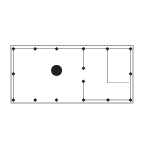Swarm City Axonometric
Swarm City
Swarm City has no interest in tenses. Though it is a product of the past and the present, it is neither “pre-” nor “post-”. Rather, it intends to intercede precisely when and where it means to, between 1950 and 1970 in Phnom Penh, Cambodia as its population begins to distend. Its precedents both predate and secede it in which case it is both speculative about a future that is but never was, and retrospective. Though suggesting its situation in the past is not to say it is any less related to the present, only that the past seems an opportune moment to begin to intervene, and the present, a good moment to examine its existence, having accrued a certain biological patina “post-occupancy”. Swarm City arrives as a sort of hydraulic urbanism. Buildings, and streets, are anamorphic, they become urban insects flocking to the site above the flood plain adjacent to the Mekong River, comprising a new city form. By means of bio-parametric tiling the swarm becomes a composition of streets, markets, paths, parks, libraries, alleys, restaurants, apartment towers, schools, stadia, and stores. It is a city not wedged between geology and biology, rather, it is a city that is organic, and deeply corporeal. All urban activity is suspended above the wetlands, which swell and recede beneath the stacks of animate form, characters that move from object to field to swarm.
Plan
The ideological matter comprising the narrative urbanism, Swarm City, though unique, is not baseless. Swarm City takes part in a larger, and very long discussion about what our cities could look like and is arranged, as one layer among many in a lineage of such urban actions, experimentations and colonial urban schema (extant and unrealized). Time in this fictive urban narrative, however, is treated non-linearly, which allows me to be editorial with history and intervene presently in the past, inserting a layer into the aforementioned lineage not at the top, but rather by starting at the top and “reshuffling the deck,” so to speak. Other urban characters in this fictional, genealogical “deck” are, in no particular order, Chandigarh, Plan Obus, Dhaka, New Babylon, and Plug-in City.
Wormseye Axonometric
Beyond its participation in this historical dialogue concerning the ideal city, Swarm City is deeply rooted in its geo-cultural site by virtue of a number of formal allusions to vernacular architectural vocabulary, and thorough site considerations. Situated along the banks of the Mekong River, Swarm City is a hydraulic city. This is not a revolutionary but rather an evolutionary trait. Historically, the dominant method of land management has been through hydraulics. In the Mekong River Valley, natural and manmade prek (canals) and beng (ponds) are used to manage water distribution. In areas above the flood plain, baray (reservoirs) are built to store water thus distributed. In effect, the Mekong River Valley is a liquid matrix. Flooding is the major constraint to the development of human settlements, subsequently the highest flood levels determine the location of Khmer cities. The ground plane of Swarm City is cartesian, though rather than operating in two dimensions, it is animated on the x-, y-, and z-axes. Its primary mode of translation is vertical to accommodate the flood waters as they rise and recede. In that way, its proximity to flood zones is not determined by flood levels, only its coordinates along the z-axis. The length of its legs.
Wireframe Axonometric
Swarm City is formally invested in the language New Khmer Architecture. New Khmer Architecture is a mutation of elements from the modernist movement augmented by the Angkor tradition indigenous to the region and the vernacular of the ordinary Cambodian houses. This architectural cross-pollination tends to produce buildings that prioritize protection from flooding and ventilation strategies. The featured import of this architectural style to Swarm City, is the architectural “leg”. The leg is at once a reference to Le Corbusier’s piloti, and something truly indigenous to Cambodian architecture. The stilt has long been a climactic tool, only it has been thickened and strengthened in its urban application to become the muscular concrete leg. Due to its scalar quality, the leg becomes a motif in the city. At low density, large-scale legs create opportunities for breezeways, and in high density, the legs become a screen or brise soleil, each acting to aid the city’s respiratory system. They are thermal masses and prioritize ventilation and shade. The legs of the city are permissive of informal infill. Much of the richness of Swarm City’s urban fabric is ad-hoc, and unplanned; richness cultivated when inhabitants begin to edit vacant or unclaimed spaces. It is a lived-in city. Elements engage in a field-like condition, a composition of interconnected surfaces and volumes, however, characterized by these legs, the city becomes anamorphic and mobile. In that sense field and swarm collapse conceptually, one atop the other. This conceptual flattening of field and swarm then enables the necessary movement for complementary elements to bio-parametrically tooled and tiled.
Perspective
Swarm City operates at the edge of control. It is a collective, inhabitants and urbanism in motion. With so many moving parts, it must admit the possibilities of a more fluid, bottom-up approach. The tropical landscape and the urban fabric are interwoven. Its elevated streets and legged urban volumes are a collage of human activity, and divine biological fecundity.
Program: Urban
Location: Phnom Penh, Cambodia
Year: 2014
Copyright © 2018 Evio Isaac





